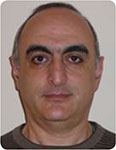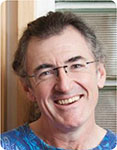Productivity decline in a Salamander geothermal well: experiment, modelling and case study
Zhenjiang You A , Alexander Badalyan A , Pavel Bedrikovetsky A , Martin Hand A and Chris Matthews AUniversity of Adelaide
The APPEA Journal 54(1) 345-356 https://doi.org/10.1071/AJ13035
Published: 2014
Abstract
Substantial formation damage and productivity decline have been observed in numerous geothermal fields. Comprehensive analysis of formation damage and prediction of productivity specifically for geothermal reservoirs, however, are not available in the literature. On the basis of laboratory study and mathematical modelling, the present work is focused on the analysis of formation damage mechanism to diagnose and predict the productivity decline.
A case study of a typical Australian geothermal reservoir (Salamander field) is performed. In this case, fines migration is recognised as the most likely candidate of all formation damage mechanisms. The attaching electrostatic forces are weak at high temperatures if compared with drag and lifting forces, which detach the particles from rock surfaces. Mobilisation of lifted fines results in particle straining in thin pore throats preferentially near the well, causing severe permeability and well productivity decline. A new model based on laboratory study is developed and field production data are successfully treated by the model.
The potential for fines migration and induced formation damage in geothermal wells is significantly higher than that for conventional oil and gas wells due to the weakening of attaching electrostatic forces under high temperatures. The evaluated well index from field data is in good agreement with mathematical modelling prediction.
The proposed model allows for long-term productivity prediction from a short production period, which allows recommending methods of skin prevention, mitigation and removal. The model is also applicable to shale, CBM, and tight oil and gas reservoirs.

Zhenjiang You is a research fellow in the Australian School of Petroleum (ASP) at the University of Adelaide. His research interests include suspension/colloid/nanoparticle transport in porous media, fines migration induced formation damage in oil/gas/geothermal reservoirs, and flow distribution within gas and oil wells. Zhenjiang received both his BEng degree in engineering mechanics and his PhD in fluid mechanics from Zhejiang University. He is the author of 70 papers in international journals and conferences. zhenjiang.you@adelaide.edu.au |

Alexander Badalyan is a senior research associate in the Australian School of Petroleum at the University of Adelaide. His research interests include: suspension flow in porous media; characterisation of porous solids by manometric gas adsorption; application of supercritical and liquid CO2 for extraction of essential oils; dissolved gas-in-oil analysis for condition monitoring of power transformers; and thermophysical properties of gases and liquids. Badalyan is the co-author of one Australian patent and is the author/co-author of one book chapter, 24 peer-reviewed publications in international journals, 8 international conference papers and 21 conference presentations. He holds a bachelor's degree in Automatic Control from the Grozny Petroleum Institute (USSR) and a PhD Degree in Theoretical Fundamentals of Heat Engineering (Thermal Properties of Fluids) from Azerbaijan Petroleum and Chemistry Institute (USSR). alexander.badalyan@adelaide.edu.au |

Pavel Bedrikovetsky is an author of two books in reservoir engineering and has published 150 technical papers in international journals and SPE. His research covers formation damage and IOR. Pavel holds a MSc in applied mathematics, a PhD in fluid mechanics, and a DSc in reservoir engineering from Moscow Oil-Gas Gubkin University. From 1991–94 Pavel was a visiting professor at Delft University of Technology and at the Imperial College of Science and Technology. Since 1994, Pavel has been a Petrobras staff consultant. Presently, Pavel holds the Chair in Petroleum Engineering at the University of Adelaide. He has served as a Section Chairman, short course instructor, key speaker and Steering Committee member at several SPE conferences. Pavel was a 2008–2009 SPE Distinguished Lecturer. pavel.bedrikovetski@adelaide.edu.au |

Martin Hand is presently the director of the South Australian Centre for Geothermal Energy Research (SACGER), deputy director of the Institute for Mineral and Energy Resources (IMER), and head of geology and geophysics in the Department of Earth and Environmental Sciences at the University of Adelaide. He has an honours degree from the University of Newcastle, and a PhD from the University of Melbourne. Martin's PhD work focused on the structural and metamorphic evolution of Proterozoic terrains in Antarctica and central Australia. Following his PhD, Martin was awarded an ARC Postdoctoral Fellowship (APD) at the University of Adelaide where he continued to investigate the thermal evolution of the continental crust. He was then awarded an Australian Research Council Research Fellowship (ARF). The emphasis of this research involved investigating the origin of high temperature processes in the crust, and the role heat-producing elements—such as uranium and thorium—play in controlling the geological record of the Australian continent. Martin was appointed as a lecturer in 2000 at the University of Adelaide, and together with colleagues formed the Continental Evolution Research Group (CERG), which now forms a unit in the Centre for Tectonics Resources and Exploration (TRaX), of which he was formerly the director. More recently, Martin has integrated his research interests with the geothermal energy industry, and seeks to assist the geothermal energy sector in bringing projects to demonstration. martin.hand@adelaide.edu.au |

Chris Matthews is presently a research officer and project manager at the SACGER, and is also the business development manager geoscience for IMER, University of Adelaide. He holds a Bachelor of Science degree with Honours in Geology from the University of Adelaide, and his PhD research in heat flow and geothermal energy is presently before the examiners. Chris has around 15 years' experience in the minerals exploration and mining sector, natural resource management and geothermal exploration. Chris was the co-founder and first CEO of Torrens Energy Limited. He was CEO for two years and chief geologist for a further two years. As the chief geologist he was responsible for designing, organising, and carrying out exploration programmes for geothermal energy targets in Australia. While at Torrens Energy, Chris was successful in discovering the world-class Parachilna Geothermal Play in SA. Prior to co-founding Torrens Energy, his early geothermal research work led to the discovery and definition of Australia’s first hot sedimentary aquifer (HSA) resources that were located in the heart of existing power infrastructure. Chris was a founding member of the Australian Geothermal Energy Association (AGEA) executive from 2008–10. He was also the AGEA Technical Manager in 2010, with active roles in technical, legislative and policy development. chris.matthews@adelaide.edu.au |


